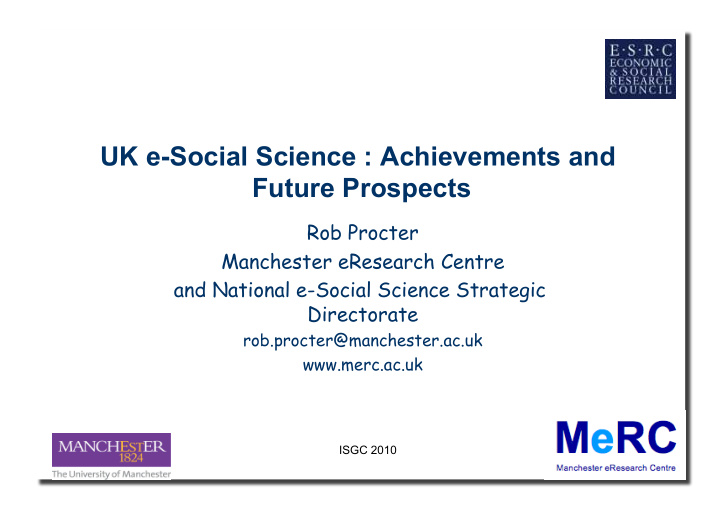



UK e-Social Science : Achievements and Future Prospects Rob Procter Manchester eResearch Centre and National e-Social Science Strategic Directorate rob.procter@manchester.ac.uk www.merc.ac.uk ISGC 2010 1
Overview Summary of UK e-Social Science research programme. Review of challenges for e- Social Science. ISGC 2010 2
Programme Aims Enable social scientists to develop methods and tools they need to address new research challenges. Investigate barriers to adoption and help UK e-Science programme achieve its objectives. ISGC 2010 3
Research Challenges Global Economic Performance, 1. Policy and Management Health and Wellbeing 2. Understanding Individual 3. Behaviour New Technology, Innovation 4. and Skills Environment, Energy and 5. Resilience Security, Conflict and Justice 6. Social Diversity and 7. Population Dynamics
Research Agenda Applications: – Tackle substantive problems by developing e- Infrastructure to enhance existing research methods and stimulate new ones – Encourage interdisciplinary research partnerships Social shaping: – Socio-technical factors in development and use of e-Infrastructure – Pathways to facilitate transfer of innovations to wider social science community ISGC 2010 5
Quantitative Analysis Tools GWR* doesn’t scale well with number of observations. multiR – parallel version of R – reduces time from weeks to hours. *GWR = geographically weighted regression
Visualisation Tools
Visualisation Tools
ISGC 2010 9
Virtual Research Environments A collaboration space for social scientists. A means to share scientific resources across a diverse community. Integrates aspects of the Social and Semantic Web. www.ourspaces.net ¡
Social Simulation National e-Infrastructure for Social Simulation project (NeISS): – Introduce social scientists to new ways of thinking about social problems, provide new services and tools to support them – Enable researchers to create workflows to run simulations, visualise and analyse results, publish for future discovery, sharing and re- use – Facilitate development and sharing of social simulation resources, encourage cooperation between model developers and researchers – Foster adoption of simulation as research method, and as decision support tool in public and private sectors
NeISS Overview Growing demand for social simulation. Applications: – Economics, geography, sociology – Health sciences, politics, anthropology Methods: – Agent-based models – Microsimulation Impact: – Theory to policy – Analysis, projection, forecasting, scenarios
Simulation of Epidemics Ferguson et al, Nature, 2005
Urban Simulation Can we project the population of a city forwards in time over a 25 year period? – Technically and intellectually demanding – Policy relevant: • housing, transport, health care, education, … Three components: – Population reconstruction – Dynamic simulation – Activity and behaviour modelling
Health and Social Care 2006 2001 2016 2031
Transport Population and average speed changes in Leeds from 2001 to 2031
2031 2001 2031 Transport 2015 Traffic Intensity * * Traffic Intensity=Traffic load/Road capacity
Map of e-Social Science projects PolicyGrid ¡ Rural communities National e- Science DAMES ¡ Centre Digital Economy National Social Inclusion Hubs Centre NeISS ¡ for Text Genesis ¡ CQeSS ¡ Mining MoSeS ¡ Obesity ¡e-‑Lab ¡ DReSS ¡ Creative Industries MiMeG ¡ Genesis ¡ OeSS ¡ eStat ¡ GeoVUE ¡ LifeGuide ¡
Relevance to Strategic Priorities ISGC 2010 19
Supporting Research Lifecycle e-Social Science projects cover whole of research lifecycle eStat GeoVUE Publication Visualisation CQeSS Literature search NaCTeM eStat Analysis Literature MoSeS review MiMeG Data security Data discovery PolicyGrid Obesity e-Lab Data collection/re- Data integration use DReSS Data preparation DAMES LifeGuide ISGC 2010 20
Challenges I New sources of data offer a rich resource for social research: – Web (news sites, wikis, blogs, …) – digital communications (email, newsgroups, speech, SMS, …) – administrative (health records, ...) – transactional records (purchases, ...) Need to harness powerful, new tools such as data and text mining if this ‘born digital’ data is to exploited ISGC 2010 23
Challenges II Wide adoption and maximum impact: – Potential adopters must: • be aware of e-Social Science • appreciate its benefits • be willing to invest in new skills • have access to appropriate facilities and support e-Uptake project: – identifying recurring, widespread barriers – devising training-based interventions ISGC 2010 24
Understanding Users Interest in e-Social Science uniform across discipline areas and research methods. 33% ‘early adopters’ 43% ‘interested’ 10% ‘unengaged’ 8% ‘sceptics’ http://www.informaworld.com/smpp/title~content=t713442842
Challenges III Unengaged Cost Innovation Pipeline Interested Early Adopters Sustainable ..? ISGC 2010 26 Time
Finally … Thanks to: Peter Halfpenny, Dave De Roure, Marina Jirotka, Anne Trefethen, Mark Birkin, Andy-Hudson-Smith, Richard Milton and many more www.merc.ac.uk www.eresearchsouth.ac.uk/uk-e-social- science ISGC 2010 27
Recommend
More recommend